Where Questions for Kids:
How to Teach Where Questions in Speech Therapy
“Where” questions are among the first we teach to children learning to answer questions, along with “who” and “what” questions. Here are our steps for teaching a child to answer “where” questions.
How to Teach Where Questions:
Many children with speech and language delays have difficulty answering different types of questions. The best way to help your child with this is to teach her one question word at a time. Once she can answer that question in a variety of different ways, you can move on to teaching other ones. Eventually you will want to mix up the types of questions you ask but for now, just stick with one. Where questions are typically the first ones I target after yes/no and “what”. This seems to be the next easiest one for kids to answer. This article will give you 5 easy steps to teaching where questions for kids.
Where Questions for Kids 1:
Point to Body Part (Where’s Your Nose?)
These are the easiest type of where questions for kids that I know of. This step is simple, just ask your child to show you all of their body parts. This is a pretty common game between young children and their parents but often the parents say “show me your nose”. There’s nothing wrong with that, but if you’re trying to teach your child where questions, ask “where’s your nose” instead. After you ask the question “where’s your ____?”, pause for a moment to see if your child will point to that body part. If not, point to it on your own body and see if your child will imitate you.
If she still doesn’t do it, move her finger to point to the correct body part. Clap for her and get very excited, even if you had to do it for her. Try it again. Every time you ask the where questions, use the same prompting. First pause and see if she’ll do it on her own, then do it on yourself, then help her do it. Hopefully, after a while of you helping her, she’ll be able to do it with just the model of you pointing to your body part. Then eventually, she’ll do it on her own. This is called fading your prompts. You only provide as much prompting as she needs that time and eventually you fade until you’re not giving any prompts at all. Keep doing this until she can point to quite a few body parts when you ask.
Where Questions for Kids 2:
Point to Location (Where’s the Ball?)
For the next where questions for kids you want to move to having her point to an object or picture when you ask wherew questions. You can do this by asking him to point to something in the room or something in a book. Start with simple words that your child knows, like “ball”, “bubble”, or her favorite food. You could even put two things on the table in front of him and say “where’s the ___?”.
Use the same prompting that you did in the last step. First ask the question “where’s the ____?” and then pause. If he doesn’t do it, point to the thing with your own finger and say “there it is!”. If he doesn’t imitate your pointing, point his finger toward the object for him and get excited. Celebrate every time your child points, even if you have to help him. Keep doing this until he can point to a variety of objects.
Where Questions for Kids 3:
Name Location from Two Choices (Where’s the Block?)
For these where questions for kids, you will need to locations and a block (or other small object). Your two locations can be toy locations like a barn and a house, or real locations like the couch and the floor. Just make sure your child knows what these things are called. You may need to teach your child what they are called before you start this activity. Now, take the block and place it in one of these locations. Ask your child “where’s the block?”. Your child should answer “on the ____” with the correct location.
At first, you will need to help your child with this. Start by asking the question and pausing. If she doesn’t answer point to or tap the correct location. If she still doesn’t answer say “on the…” and pause again. If she’s not able to give the answer after that, provide her with the full response (on the couch) and then have her imitate you. Each time you ask the question, use the prompts as described above, pausing after each one. Hopefully, she will need fewer of those prompts as you go along. As usual, celebrate for her when she gets one, even if you need to help her.
Where Questions for Kids 4:
Name Location Immediately Present (Where’s Your Shoe?)
The activity for these where questions is much like the last activity though your child will have more than two options. Start with one object and move it around the room. Place it in different locations and ask your child “where’s the shoe (or whatever object you choose)?”. Help your child give you a verbal description of where that object is. It might be on the chair, on the floor, in the kitchen, down the stairs, etc. You could also place it in different rooms in the house and have him answer with the room that it is in. Use the following prompts and fade back as you are able to:
- Ask the question and pause
- Point to the location of the object
- Start the response but pause before the location word (such as “on the…”)
- Give your child the whole answer and have him imitate it back to you
Keep doing this until he can answer where questions about a variety of things that are immediately present. You can also ask questions about actions that he or others are doing. You can ask questions like “where are you washing your hands?” or “where is daddy going?”
Where Questions for Kids 5:
Name Hypothetical Location (Where Do You Sleep?)
Now it’s time to start asking where questions about more abstract concepts, such as things that are not immediately present. You will need to start asking questions like “where do you wash your hands?” or “where do you eat dinner?”. It may be helpful at first to provide your child with choices. You can offer verbal choices, like “where do you eat dinner? At the table or in the bathtub?”. You could also provide your child with picture choices. You could take pictures of various places around your house and show her two or more choices when you ask the question. I have also created three file folder games with questions like this which you can download and print for free so that you have picture questions and answers to practice with your child.
There you go! Once you get through those five steps, just keep asking a variety of “where” questions until he is able to answer them consistently. Then, you can move on to teaching another type of “wh-“ question.

About the Author: Carrie Clark, MA CCC-SLP
Hi, I’m Carrie! I’m a speech-language pathologist from Columbia, Missouri, USA. I’ve worked with children and teenagers of all ages in schools, preschools, and even my own private practice. I love digging through the research on speech and language topics and breaking it down into step-by-step plans for my followers.
Connect with Me:











The large rectangles that say Where is not on the print out. How can I get this so I can make the file folder games?
Hi, Joan-
Please let me know if this is the file you were looking for. If not, please email us at speechandlanguagekids@gmail.com so we can work with you further.